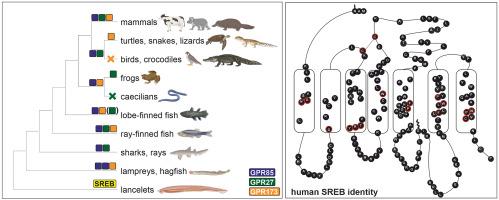Pharmacology & Therapeutics ( IF 12.0 ) Pub Date : 2022-05-26 , DOI: 10.1016/j.pharmthera.2022.108217 Claudia Stäubert 1 , Monika Wozniak 2 , Nadine Dupuis 2 , Céline Laschet 2 , Thanigaimalai Pillaiyar 3 , Julien Hanson 4

|
GPR27, GPR85 and GPR173 constitute a small family of G protein-coupled receptors (GPCR) that share the distinctive characteristics of being highly conserved throughout vertebrate evolution and predominantly expressed in the brain. Accordingly, they have been coined as “Superconserved Receptors Expressed in the Brain” (SREB), although their expression profile is more complex than what was originally thought. SREBs have no known validated endogenous ligands and are thus labeled as “orphan” receptors. The investigation of this particular category of uncharacterized receptors holds great promise both in terms of physiology and drug development. In the largest GPCR family, the Rhodopsin-like or Class A, around 100 receptors are considered orphans. Because GPCRs are the most successful source of drug targets, the discovery of a novel function or ligand most likely will lead to significant breakthroughs for the discovery of innovative therapies.
The high level of conservation is one of the characteristic features of the SREBs. We propose herein a detailed analysis of the putative evolutionary origin of this family. We highlight the properties that distinguish SREBs from other rhodopsin-like GPCRs. We present the current evidence for these receptors downstream signaling pathways and functions. We discuss the pharmacological challenge for the identification of natural or synthetic ligands of orphan receptors like SREBs. The different SREB-related scientific questions are presented with a highlight on what should be addressed in the near future, including the confirmation of published evidence and their validation as drug targets. In particular, we discuss in which pathological conditions these receptors may be of great relevance to solve unmet medical needs.
中文翻译:

大脑中表达的超保守受体:孤儿受体家族的表达、功能、基序和进化
GPR27、GPR85 和 GPR173 构成 G 蛋白偶联受体 (GPCR) 的一个小家族,它们具有在整个脊椎动物进化过程中高度保守并且主要在大脑中表达的独特特征。因此,它们被称为“大脑中表达的超保守受体”(SREB),尽管它们的表达谱比最初想象的要复杂。SREB 没有已知的经过验证的内源性配体,因此被标记为“孤儿”受体。对这种特定类别的未表征受体的研究在生理学和药物开发方面都有很大的前景。在最大的 GPCR 家族中,类视紫红质或 A 类受体中,大约有 100 个受体被认为是孤儿。因为 GPCR 是最成功的药物靶标来源,
高水平的保护是SREBs的特征之一。我们在此建议对该家族的推定进化起源进行详细分析。我们强调将 SREB 与其他类视紫红质 GPCR 区分开来的特性。我们提供了这些受体下游信号通路和功能的当前证据。我们讨论了鉴定 SREB 等孤儿受体的天然或合成配体的药理学挑战。提出了与 SREB 相关的不同科学问题,并重点介绍了在不久的将来应该解决的问题,包括已发表证据的确认及其作为药物靶点的验证。特别是,我们讨论了这些受体在哪些病理条件下可能与解决未满足的医疗需求有很大关系。











































 京公网安备 11010802027423号
京公网安备 11010802027423号